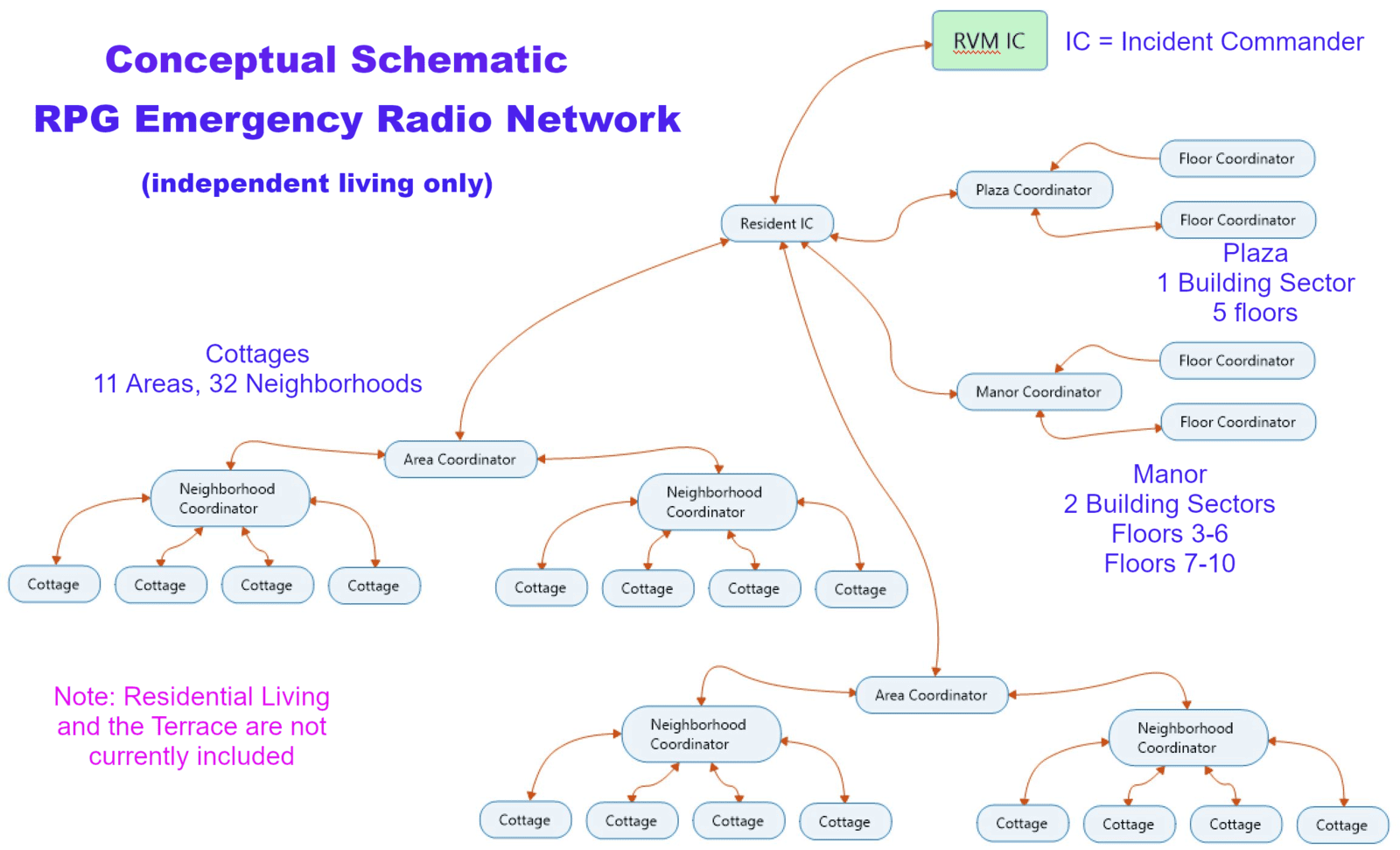Update 04/05/21:
Communication Team Leader: Dan Curtis; team members — Wes Freeman, Ken Kelley, and Scott Wetenkamp
The plan presented below is in the process of implementation.
- Radios for Area and Neighborhood/Floor Coordinators have been purchased with funding provided through the Residents Council.
- Channel assignments have been developed for the various areas; radios are being charged and set before distribution to the coordinators.
- Tests have determined that radios can be used effectively within the high-rise buildings.
- Familiarization, training, and radio use protocols are being developed to make the network operational.
RPG Emergency Radio Network
By Bob Buddemeier, Dan Curtis, Bob Walden, and Scott Wetenkamp
Network Initiation
In the late summer of 2019, a small group of volunteers initiated what became the Residents’ Preparedness Group (RPG). The purpose of RPG is to support RVM efforts to build resident preparedness for emergencies and disasters, and to assist with responses in case of an event. The motivation was the recognition by all concerned that in some emergency or disaster scenarios, staff and resource limitations would prevent RVM from providing Independent Living (IL) residents with all the assistance needed.
The RPG team contains individuals with backgrounds in military logistics, management, civil administration, medicine, engineering and research. The core group quickly recognized that communication Between RVM and residents was the foundation for effective cooperation and action, and set about developing a robust IL resident communication system.
Beginning with the cottage areas, RPG designed a system in which neighborhoods of not more than 10 residential units were defined, and grouped into areas of 1-4 neighborhoods. In case of a disaster or warning, Neighborhood Coordinators would make personal contacts and relay necessary information up or down the communication chain. The diagram and the Structure and Operation section below describe the system in more detail; links to maps and coordinator directories are at the end of the article.
The cottage network has been radio-tested to insure that the design permits reliable communication with hand-held radios, and the organizational concept has been extended to the Plaza and Main Manor, with Building or Building Section and Floor coordinators.
The validity of this approach was dramatically confirmed by the Almeda fire evacuation, when neither RVM nor County information channels could supply residents with accurate, up-date information. Door-to-door personal notifications were made by both staff and RPG volunteers, even though the RPG network had not yet been fully implemented and was not equipped as designed.
Following the evacuation experience, RVM initiated a major preparedness program, led by Asst. Direc. Alexander Ben-Israel. RPG and RVM have agreed that RPG support will be an integral part of the ultimate preparedness system, and RPG is undertaking the next major development step.
RPG is currently purchasing hand-held radios for the network. This purchase was budgeted by the Residents Council and RVM for the present fiscal year. When received, radios will be issued to each Coordinator and other key personnel, and training initiated.
This is the beginning of a major development that will extend over weeks and months. In addition to training and practice, we will need to evaluate experience, especially with communications within the Plaza and Main Manor. The goal is to have the RPG component of the overall system ready to participate in site-wide exercises when RVM completes its preparedness task later this year.

Network: Structure and Operation
The Residents’ Preparedness Group is implementing a hierarchical communication system to facilitate emergency communication between residents and the RVM Incident Commander. At the base of the hierarchy, a neighborhood coordinator (in the cottages) or floor coordinator (in the towers) is responsible for a number of residential units that he/she can quickly reach on foot to establish person to person communication. The neighborhoods are grouped into 11 Areas (typically 3-4 neighborhoods/area), which are overseen by an Area coordinator. In the towers, the equivalent positions are Floor coordinator and Building sector coordinator, with 4-5 floors per sector. In addition to these two levels of coordination, there is a Resident Incident Commander, who is the link to the RVM Incident Commander. All coordinators are equipped with radios operating on assigned channels. In an emergency, this hierarchy will be used to transmit warnings, instructions and requests for action from the RVM Administration (IC) to all individual residents, and the local coordinators will report on resident status and needs upwards to RVM through the Area coordinators and ICs. If communication between the ICs is disrupted or RVM cannot respond to resident needs, the resident network can operate autonomously to facilitate cooperation and mutual support among the residents.
Establishment and maintenance of resident emergency communication capability will include:
• Testing, inventory and distribution of radios to coordinators
• Novice training — Familiarization with basic use and maintenance for coordinators without prior radio experience
• Scheduled biweekly and informal (ad-lib) practice sessions — To build familiarity, to maintain competency and provide opportunities for evaluation.
• Intermediate training — Instruction and practice in specific procedures for emergency transmission/receipt of information.
• Advanced and intermediate training examples — Table-top and field exercises to apply skills and principles to a variety of scenarios.
Note 1: Details in the above and attached material are subject to change.
Note 2: Training for Area/Building coordinators will be more extensive because of the need to operate on two different channels and because of possible channel conflict with radio use in Medford.
Note 2: Training and operational details will differ between the cottages and the towers because of physical differences in the environments.
Attachments:
Maps of cottage areas: download pdf https://thecomplement.info/wp-content/uploads/2020/09/RVM-neighborhoods.pdf
Table of Coordinators: download pdf https://thecomplement.info/wp-content/uploads/2020/06/coordinators-2-4-21.pdf

